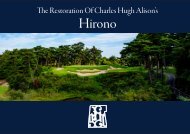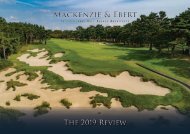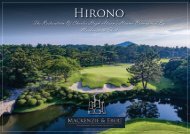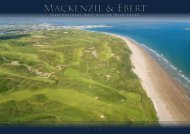Create successful ePaper yourself
Turn your PDF publications into a flip-book with our unique Google optimized e-Paper software.
Introduction & Heritage<br />
If Mackenzie & Ebert was fortunate to be commissioned, there was a belief that this would be<br />
a project to relish when contact was first made with the committee at <strong>Hirono</strong>. <strong>The</strong> committee<br />
was named ‘<strong>The</strong> <strong>Restoration</strong> Committee’. Nothing could be closer to our hearts, especially<br />
when we saw the plans which C.H. Alison had drawn up and also the incredible archive of<br />
photographs which the Club held from the 1930s, shortly after the course opened on the 19th<br />
of June 1932. Alison had been asked to design Tokyo Golf Club but, during his 3 months in<br />
Japan, he was asked to look at numerous other sites for courses and <strong>Hirono</strong> turned out to be<br />
the most famous of them.<br />
<strong>The</strong> opportunity to view the course revealed a wonderful layout with no weak holes at all. <strong>The</strong><br />
topography could be described as ideal for golf, containing enough movement throughout<br />
without it producing a tough walk. <strong>The</strong>re are many distinct ravines and softer valleys which<br />
feature on so many of the holes. As was usual for Colt & Alison’s courses, the four par 3s really<br />
stand out as inspired although, interestingly, they are all odd numbered so surely Alison must<br />
have asked if there was much likelihood of foursomes golf being played on the course! <strong>The</strong> par<br />
5 15th is regarded by the members as perhaps the best hole but this could be partly as a result<br />
of Jack Nicklaus being the first man to hit the green in two shots in the 1960s!<br />
Following two visits to work up proposals and discuss the project with the <strong>Restoration</strong><br />
Committee, Mackenzie & Ebert was commissioned. <strong>The</strong> strong brief was to restore the great<br />
work which Alison left although, at this point, reference should be made to the significant input<br />
of Seiichi Takahata, who found the site and was also one of Club’s founders, and Chozo Itoh,<br />
the first Course Superintendent. <strong>The</strong>y were the key figures who had the task of implementing<br />
Alison’s design as he spent less than a week in Kobe to study the land and draw up his design.<br />
<strong>The</strong> wonderful character of the bunkering shown in the early photos had led to the comparison<br />
with Pine Valley although <strong>Hirono</strong> is not blessed with Pine Valley’s sandy soil. That shows what<br />
an amazing job was done by the construction team in those early days and the photograph at<br />
the top right, showing the workers in action creating the huge and beautifully shaped carry<br />
bunker at the 18th hole, illustrates the level of creation and artistry which was employed.<br />
<strong>The</strong> 18th hole under construction<br />
We added to the archive by tracking down old aerial photography of the course from the<br />
1940s and 1960s. Along with Alison’s plans and the Club’s photographs, these showed that<br />
the greens had become smaller, the fairways had become much narrower, the bunkers had<br />
lost their shape, character and roughness and the trees had grown significantly although<br />
the original course was cut through pine woodland. Only one hole had been significantly<br />
extended and, in fact, that had happened twice with new greens being pushed back on both<br />
occasions. That was the par 5 12th and the second extension had led to the par 3 13th hole<br />
being played from a new tee at right angles to Alison’s hole. <strong>The</strong> original playing line of the<br />
par 3 was something the Committee was very keen to restore back to its original playing line.<br />
We also studied the results of the most recent elite events at the course including the Japan<br />
Open of 2005 and the Japan Amateur in 2012. It was interesting to see how the holes played<br />
in those two tournaments.<br />
<strong>The</strong> 18th hole shortly after opening

















